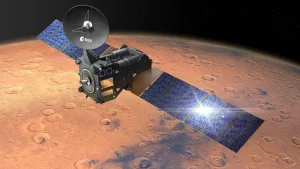What would happen if aliens contacted us? It’s a longstanding question that now has at least a partial answer, after a transmission designed to mimic correspondence from an extraterrestrial civilization made its way to Earth from Mars.
The event — organized by SETI, a nonprofit organization with a mission to search for extraterrestrial intelligence and explore the origin of life in the universe — straddles the line between art project and technical rehearsal. It is meant to explore the process of decoding and interpreting an intelligent signal from the cosmos and how it would impact humanity.
The message went out on May 24 from the ExoMars Trace Gas Orbiter, a spacecraft launched in 2016 that is currently orbiting Mars to study its atmosphere. The transmission traveled across space for 16 minutes before being successfully picked up by three observatories: the Allen Telescope Array in Northern California, the Green Bank Telescope in West Virginia, and the Medicina Radio Astronomical Station near Bologna, Italy.

Once received, the raw data containing the message was released on the internet via Filecoin, a large decentralized storage network, to give everyone a chance to decode it and interpret its meaning. A few days on, the collaborative effort is still ongoing, and a Discord channel has been set up for public discussion.
“I can’t really say anything about the content of the message, and we’ll only start giving some hints if we see that people really struggle,” said SETI member Daniela de Paulis, the artist who created the message, in a phone interview. “It will take some time, because it requires people with different expertises to collaborate with each other, which was really the objective of the project: an extraterrestrial message would belong to all humanity, so we should all have the ability to contribute to its interpretation.”
Deciphering an alien transmission
De Paulis, who is also a licensed radio operator, started working on the project, called “A Sign in Space,” in 2021.
“I was working with astronomers, anthropologists and other scientists, it was a very interdisciplinary group, and we also had artists from different fields,” she said. “We were meeting on a monthly basis, brainstorming ideas on what a possible extraterrestrial civilization would send to us. After that, I narrowed the group down to five people, and then eventually down to three — because it was really important that not many people knew about the content.”
The message, which is only a few kilobytes in size, had to be disentangled from the rest of the raw data received during the transmission, which might have included background noise, telemetry data and spurious information. This first step in the process, according to dePaulis, requires very specific technical knowledge. “But then, everyone can join in for the cultural interpretation, which for me is the most exciting part,” she said.
























